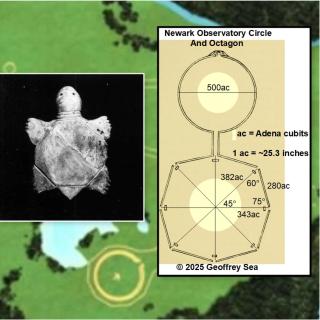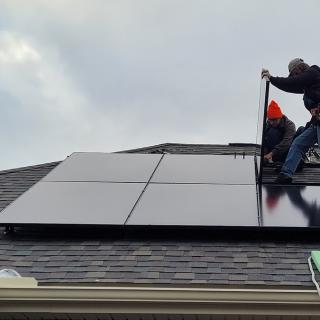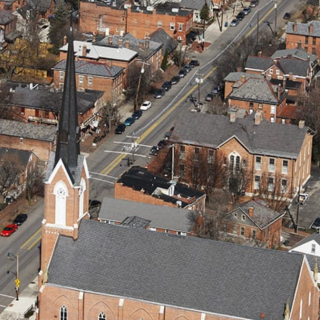On December 2, 2013, the U.S. Nuclear Regulatory Commission (NRC) held a public meeting on “Waste Confidence” in Perrysburg, OH.
The NRC has “confidence” that the high-level radioactive nuclear waste problem will be solved sometime in the future! In 1984, in an Orwellian act, they ruled that they can continue to hand out new licenses for nuclear power reactors and give 20-year license extensions to aging, brittle, accident prone nuclear reactors – without considering public concerns about the safety, storage and disposal of thousands of tons of radioactive waste. The NRC also maintained that high-level radioactive waste is a “generic” issue. So issues specific to particular sites – such as the amount of waste accumulating in overcrowded fuel pools or in aged, deteriorated casks, or in areas prone to flood or earthquake—cannot be raised.
A year ago, after legal action by a group of organizations, including the Sierra Club, the U.S. Court of Appeals in Washington, DC overturned the NRC waste confidence ruling. This forced the NRC to halt all licensing of reactors. This includes FirstEnergy’s application for a 20-year license extension of its Davis-Besse reactor near Toledo.
So what did the NRC do? Instead of appealing the decision, which would take time and they could lose, they hastily rewrote a NEW Waste Confidence Rule restating their same unsafe, industry-friendly idea in new packaging. Due to legal requirements, the NRC held public meetings on its new rule and Draft Generic Environmental Impact Statement (DGEIS) in 11 cities across the country.
The Perrysburg, OH, meeting on Dec. 2 was second-to-last. From a crowd of about 200, there were 48 who gave statements. Speaking eloquently and emotionally, 38 people from Ohio, Michigan and a sprinkling of other states spoke out strongly against the NRC’s new proposals and the continuing generation of thousands of tons more radioactive waste from nuclear power. In Perrysburg, as across the country, those speaking in favor of the new rule all had a vested monetary interest in the nuclear industry.
The overwhelming message from the public was “stop making it.” David Ellison, Cleveland architect and Green Party leader, spoke about the permanent imposition of martial law that could accompany nuclear waste accumulation, and the relationship of nuclear enrichment to wars including Iraq and possibly Iran, and the relationship of nuclear, including uranium enrichment, to NSA spying. Ellison also said $500 billion in nuclear subsidies would hire a lot of plumbers and pipe fitters, addressing people speaking in favor. David Schonberger from Ann Arbor said that the rules the NRC is making are beyond their authority to enforce.
Evan Davis, a reporter from WCRS, Columbus’s LP FM station, audio-recorded the meeting and interviewed members of the NRC and the public. The program, called Conscious Voices, airs from 4-5 pm on Dec. 13. The program will be archived online indefinitely.
The NRC’s goal is to pass the new rule quickly and get on with extending nuclear licenses. However, the large outcry of people all across the country, exposing the NRC proposals to be superficial and incomplete, could force the NRC to make changes.
TAKE ACTION! The public has until Dec. 20, 2013 to send written comments. The NRC has a direct link to the DGEIS and proposed rule, where there are instructions for submitting comments online or via email. The NRC wanted to pass the new rule quickly and get on with extending nuclear licenses. However, the large outcry of people all across the country, exposing the NRC proposals to be superficial and incomplete, could force the NRC to make changes. Make a quick comment and add your voice.
S.B. 1240 Rears its Ugly Head
In the Sept. 26 issue of The Free Press we wrote about the Obama Administration’s Blue Ribbon Commission and their pre-ordained decision to deal with America’s high-level radioactive waste by not really dealing with it. High-level waste is defined as the irradiated fuel rods from nuclear power reactors. The Commission’s proposal, now codified as Senate Bill 1240, is to move the waste around the country, take it off the hands of the utilities that generated it, and store it “temporarily,” “somewhere.”
“Somewhere” likely being a current Department of Energy (DOE) site, such as the uranium enrichment reservation at Piketon, OH.
In Nov., 2013, Ron Wyden (D-OR), chair of the Senate Energy and Natural Resources Committee, decided he wanted the committee to hear the bill and attempt to pass it on to the full senate. While Wyden has worked hard in the past to make the NRC and DOE accountable to the public, his rushing forward with this bill, particularly at the busy Christmas month, is perplexing.
TAKE ACTION! Ohio’s Senator Rob Portman is on this committee. Contact him and tell him why you oppose this outrageous, dangerous plan. You can also find Senator Wyden and other members of the Energy committee on the web and copy them. Tell them:
* S.B. 1240, the Nuclear Waste Administration Act of 2013, has no requirement that receiving sites be geologically suitable for the de-facto permanent storage of this hazardous material.
* Interim storage, like plutonium, is forever. Sites that take it are likely to own it.
* What permanent repository will take it from interim sites? After over 60 years of U.S. nuclear experimentation, no suitable place for permanent safe storage has been found. A suitable place to store radioactivity that will be lethal for millions of years may never be found.
* Moving the waste around the country does nothing to actually solve the waste problem. And no one wants it in their back yard.
* S.B. 1240 effectively says the waste will be moved twice. This would be a huge public expense, which our nation cannot afford.
* Interim storage can override rights of state and local governments to stop the building of facilities and/or transportation of waste in their locales.
* Interim storage has immense transportation risks. Transporting the 80,000 tons of high level nuclear waste on busy highways and railroads from 103 reactors in 31 states to interim storage sites will create added risks to public health and safety with inevitable accidents and spills, as well as expose the nation to terrorist threats.
The nation does need to take immediate action on high-level radioactive waste – the irradiated fuel rods now being stored at reactor sites. Waste must be moved as quickly as possible out of fuel pools into state-of-the-art canisters that are uniformly designed. Canisters must be stored as close as safely possible to the site of generation. Whether we like the idea or not, generations to come will in turn be forced to take rolling custody of the waste. Because there is no capability of accurately forecasting geologic changes over many millions of years, radioactive waste must not be put in inaccessible places.
In a Nutshell
* Chernobyl Work began in November to remove a giant chimney from the Chernobyl sarcophagus. The chimney is being removed in order to put a giant, 360-foot tall, 843-foot wide, $2-billion arch over the remains. One of the biggest engineering projects in history, the project is complicated by radioactivity on the assembly site near the disaster. In another Chernobyl concern, a BBC News Magazine article says much of the 30km exclusion zone around the Chernobyl nuclear plant is pine forest, with some of it so badly contaminated that a forest fire could create a devastating radioactive smoke cloud.
* World Bank “We don’t do nuclear energy” was the categorical pronouncement made this week by the president of the World Bank, Jim Yong Kim. TheWorld Bank says it will not fund nuclear power, instead giving development money to sustainable energy projects.
* Paducah The Department of Energy will open negotiations with Global Laser Enrichment (GLE) for the sale of the depleted uranium hexafluoride (DUF6) at the former uranium enrichment site in Paducah, KY. GLE has proposed building a laser enrichment facility at Paducah that they say would compensate the DOE by renting the site and taking the waste DUF6 off the DOE’s hands. DOE failed to say that GLE might sell the fissionable part of any re-enriched DUF6 back to the government. DOE also failed to mention what would be done with the vast remainder, except maybe make depleted uranium weapons to contaminate other parts of the planet. While Deputy Secretary of Energy Daniel Poneman touted high-paying technical jobs that would be created, he failed to add that these aren’t jobs for average unemployed Kentuckians. The bottom line is, it’s hard to believe that GLE won’t ask for public subsidies to build this unneeded plant, using jobs as a carrot.



